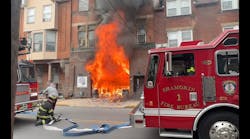The investigation of the Charleston, SC, Super Sofa Fire that killed nine firefighters has not even started. The facts of the fire will not be uncovered for months. At this time every thing is speculation. The initial television reports, which are usually incorrect, stated several causes: roof collapse, flashover, disoriented by smoke. None of these claims have been proven. No one can state exactly how these firefighters died.
However we can state facts about how firefighters die each year, throughout this country fighting fire like the Charleston Super Sofa Furniture Store fire. We can state, each year, firefighters throughout the nation, die by collapse, flashover, and deadly smoke. All of these causes of firefighter fatalities can come under the category of "caught and trapped". Caught and trapped by fire is a category of firefighter death that is increasing. The National Fire Protection Association (NFPA) conducted a 10-year study of firefighting inside burning buildings and found firefighters can be caught or trapped during fires by collapse, flame spread, smoke.
Collapse: The most common type of collapse that kill firefighters are: floor collapse, roof collapse, wall collapse and ceiling collapse, in that order. A study conducted by the NFPA from 1990 to 1999 study found in 10 years a total of 56 firefighters died by burning building collapse: 21 by floor collapse, 19 by roof collapse, 14 by wall collapse and two by ceiling collapse. An important overlooked factor about the 19 firefighters killed by roof collapse is that 15 of the 19 were operating inside the building under the collapsing roof.
Flame spread: The most deadly flame spread that kills firefighters is flashover. Flashover is a deadly surprise at a fire. Surprises like flashover and backdraft explosions often kill firefighters doing an already dangerous job of firefighting... We do not want surprises at fire scenes.
Flashover is rapid fire spread, it creates temperatures of 1,000 degrees Fahrenheit. The triggering event of flashover is heat. The fire protection engineers tell us when the temperature builds up at a fire it is absorbed into the upper walls and ceilings then at some fire the heat is radiated back down into the burning room and causes a flashover. This is called radiation feedback theory of flashover. Flashover signals the end of the growth stage of a fire and is start the active flaming fire.
Smoke: There are three stages of a fire. The first stage is called the growth stage, the second active flaming stage, and the third the decay stage. During the first stage of a fire, when first responders arrive, smoke can be deadly. The first stage of a fire creates the most quantity of smoke. This smoke can be dense, black and obscure vision. Smoke causes the loss of vision some times firefighters are blinded by smoke. When there is loss of vision firefighters are sometimes disoriented and can not retrace their steps and find the way back to an exit. Disorientation is defined as the loss of direction due to loss of vision. Firefighters first on the scene performing search and rescue or searching for the location of a fire, or operating above a fire are sometimes disoriented by smoke. When firefighters are disoriented by smoke they sometimes can not find there way back out of the burning building and are caught and trapped in the fire. When disoriented by smoke firefighters trying to escape may be killed by flashover, backdraft-explosion or collapse. The cause of death may be listed as one of these, however in some instances disorientation may actually be the cause.
For more information go to www.vincentdunn.com and use the Google search feature with keywords "Caught and Trapped".
Related Articles:
Vincent Dunn, a Firehouse Magazine contributing editor, is a 42-year veteran of the FDNY and a deputy chief (ret.), serving as division commander for midtown Manhattan. A nationally renowned lecturer, he is the author of the best-selling text and video series Collapse of Burning Buildings and the textbooks Safety and Survival on the Fireground and Command and Control of Fires and Emergencies. A new book, Strategy of Firefighting - How to Extinguish Fires will be published in April. Dunn has a master's degree in urban studies, a bachelor's degree in sociology and an associate's degree in fire administration from Queens College, City University of New York. He can be reached at 1-800-231-3388 or via through his website at www.vincentdunn.com.





